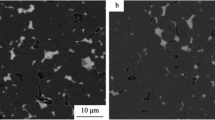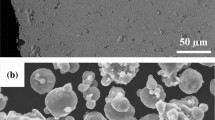Abstract
Hot corrosion behavior of Sm2(Co, Fe, Cu, Zr)17-type high-temperature magnetic alloy without and with a protective coating of Ni and Ni/Cr bilayer at 500 °C in a corrosive mixture of 75 wt% Na2SO4–NaCl for 100 h was reported in this paper. The obtained results of time-dependent weight change established the parabolic growth of oxidized surface of bare magnets (8.87 mg·cm−2), which caused a rapid loss of magnetic properties measured both at room and high temperatures (500 °C). X-ray diffraction (XRD) analysis revealed the growth of oxides for bare magnet and Cr–oxides (Cr2O3), top layer of Ni/Cr bilayer coating, but in the case of single coating, Ni–sulfides formation indicated penetration of sulfur, which is further verified by electron probe microanalysis with energy dispersive spectroscopy (EPMA/EDS) study. Results showed that bilayer-coated samples (Ni/Cr) performed better than Ni-coated and bare samples.







Similar content being viewed by others

References
Ray AE, Liu S. Recent progress in 2:17–type permanent magnets. J Mater Eng Perform. 1992;1(2):183.
Yi JH, Peng YD. Review of research on 2:17 type SmCo rare earth permanent magnets. Rare Met Mater Eng. 2004;33(4):337.
Zhang TL, Liu HY, Jiang CB. 2:17-type SmCo quasi-single-crystal high temperature magnets. Appl Phys Lett. 2015;106(16):162403.
Ma ZH, Zhang TL, Liu HY, Jiang CB. A facile synthesis of high performance SmCo5 nanoparticles. Chem Eng J. 2015;264:610.
Richard TF, Rubertus CS. Air force applications of advanced magnetic materials. In: Proceeding of Materials Research Society Spring Conference, Vol 57. San Francisco; 1999. 481.
Richard TF, Rubertus CS. Applications of high temperature magnetic materials. IEEE Trans Magn. 2000;36(5):3373.
An SZ, Jiang CB. Recent progress in high temperature permanent magnetic materials. Rare Met. 2013;32(5):431.
Chen CH, Walmer MS, Walmer MH, Liu S, Kuhl E. Sm2(Co, Fe, Cu, Zr)17 magnets for use at temperature ⩾ 400 °C. J Appl Phys. 1998;83(11):6706.
Liu JF, Chui T, Dimitrov D, Hadjipanayis GC. Abnormal temperature dependence of intrinsic coercivity in Sm(Co, Fe, Cu, Zr)z powder materials. Appl Phys Lett. 1998;73(20):3007.
Liu JF, Zhang Y, Dimitrov D, Hadjipanayis GC. Microstructure and high magnetic properties of Sm(Co, Cu, Fe, Zr)z (z = 6.7–9.1) permanent magnets. J Appl Phys 1999;85(5):2800.
Liu JF, Ding Y, Dimitrov D, Hadjipanay GC. Effect of iron on the high magnetic properties and microstructure of Sm(Co, Fe, Cu, Zr)z permanent magnets. J Appl Phys. 1999;85(3):1670.
Tang W, Zhang Y, Hadjipanayis GC. Microstructure and magnetic properties of Sm(CobalFexCu0.128Zr0.02)7.0 magnets with Fe substitution. J Magn Magn Mater. 2000;221(3):268.
Guo ZH, Li W. Room-and high-temperature magnetic properties of Sm(CobalFexCu0.088Zr0.025)7.5 (x = 0–0.30) sintered magnets. Acta Metall Sin. 2002;38(8):866.
Handstein A, Yan A, Martinek G, Gutfleisch O, Müller KH, Schultz L. Stability of magnetic properties of Sm2Co17-type magnets at operating temperatures higher than 400 °C. IEEE Trans Magn. 2003;39(5):2923.
Chen CH, Walmer MS, Walmer MH, Liu S, Kuh GE. Thermal stability of Sm–TM high temperature magnets at 300–550 °C. IEEE Trans Magn. 2000;36(5):3291.
Chen CH, Walmer MH, Kottcamp EH, Gong W. Surface reaction and Sm depletion at 550 °C for high temperature Sm–TM magnets. IEEE Trans Magn. 2001;37(4):2531.
Kardelky S, Gebert A, Gutfleisch O, Hoffmann V, Schultz L. Prediction of the oxidation behaviour of Sm–Co-based magnets. J Magn Magn Mater. 2005;290–291:1226.
Kardelky S, Gebert A, Gutfleisch O, Handstein A, Wyss U, Schultz L. Corrosion behavior of Sm–Co-based permanent magnets in oxidizing environments. IEEE Trans Magn. 2004;40(4):2931.
Pragnell WM, Williams AJ, Evans HE. The oxidation of SmCo magnets. J Appl Phys. 2008;103:(7)127.
Pragnell WM, Williams AJ, Evans HE. The oxidation morphology of SmCo alloys. J. Alloys Compd. 2009;487(1–2):69.
Saunders SRJ, Nicholls JR. Coating and surface treatment for high temperature oxidation resistance. Mater Sci Technol. 1989;5(8):780.
Chen CH, Walmer MH, Liu S. Thermal stability and the effectiveness of coatings for SmCo 2:17 high temperature magnets at temperature up to 550 °C. IEEE Trans Magn. 2004;40(4):2928.
Chen CH, Huang MQ, Foster JE, Monnette G, Middleton J, Higgins A, Liu S. Effect of surface modification on mechanical properties and thermal stability of Sm–Co high temperature magnetic materials. Surf Coat Technol. 2006;201(6):3430.
Wang Q, Zheng L, An SZ, Zhang TL, Jiang CB. Thermal stability of surface modified Sm2Co17-type high temperature magnets. J Magn Magn Mater. 2013;331:245.
Pragnell WM, Evans HE, Williams AJ. Oxidation protection of Sm2Co17-based alloys. J Alloys Compd. 2012;517(15):92.
Pragnell WM, Evans HE, Williams AJ. The oxidation kinetics of SmCo alloys. J Alloys Compd. 2009;473(1–2):389.
Yang Z, Peng X, Feng Q, Guo Z, Li W, Wang F. The mechanism of high temperature oxidation of a SmCo-based magnetic alloy. Corros Sci. 2012;61:72.
Dong Z, Peng X, Guo Z, Li W, Wang F. The effect of a surface Cr film on the oxidation of SmCo-based magnetic alloy at 700 °C. Corros Sci. 2013;77:113.
Cui J, Kramer M, Zhou L, Liu F, Gabay A, Hadjipanayis G, Balasubramanian B, Sellmyer D. Current progress and future challenges in rare-earth-free permanent magnets. Acta Mater. 2018;158:118.
B Saira, Wang J, M. Faisal Rathore, Jiang CB. Temperature stability of SmCo (2:17) magnets modified by Ni–Cr two layers coating. Rare Met. 2019;38(3):238.
Acknowledgements
This work was financially supported by the National Natural Science Foundation of China (Nos. 51761145026 and 51471016) and the Natural Science Foundation of Beijing (No. 2151002).
Author information
Authors and Affiliations
Corresponding author
Rights and permissions
About this article
Cite this article
Bibi, S., Wang, JM., Mehmood, T. et al. Hot corrosion of surface-modified Sm2Co17 high-temperature magnet with Ni and Ni/Cr bilayer coatings in 75 wt% Na2SO4–NaCl mixture. Rare Met. 40, 2494–2500 (2021). https://doi.org/10.1007/s12598-020-01604-0
Received:
Revised:
Accepted:
Published:
Issue Date:
DOI: https://doi.org/10.1007/s12598-020-01604-0



